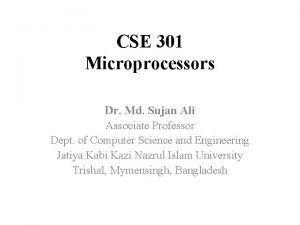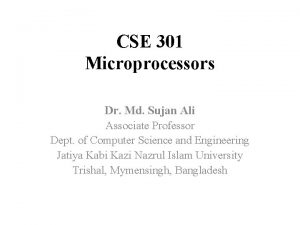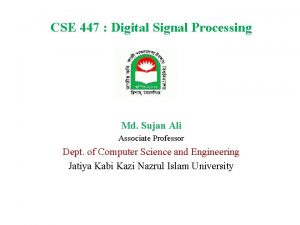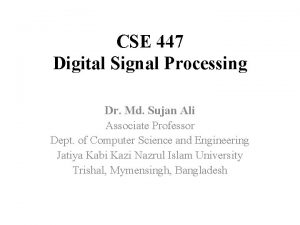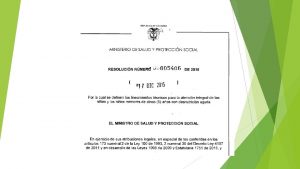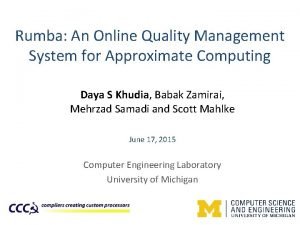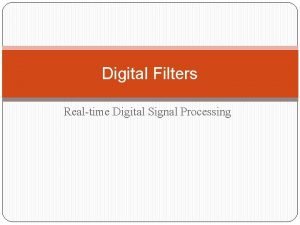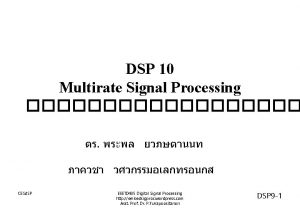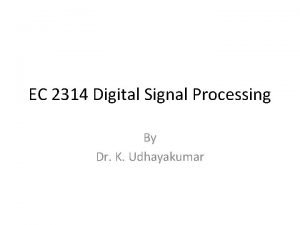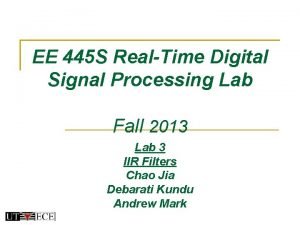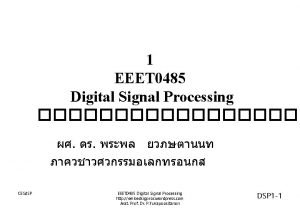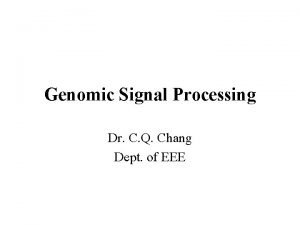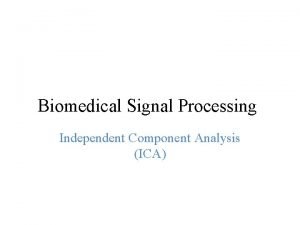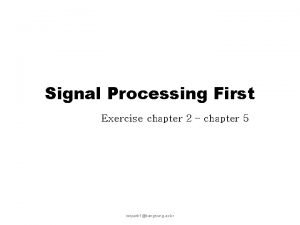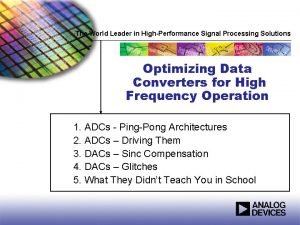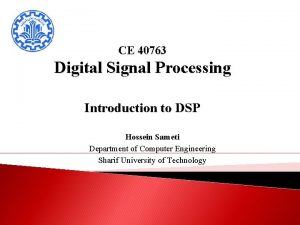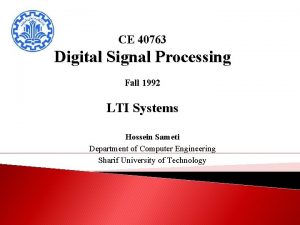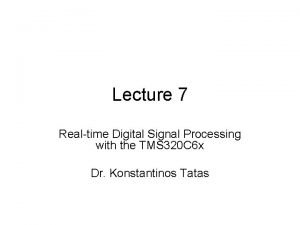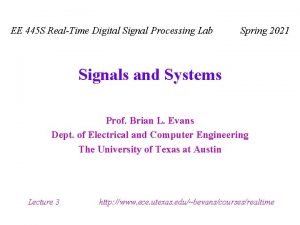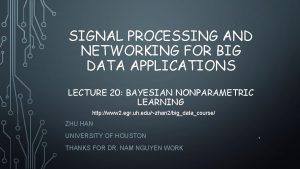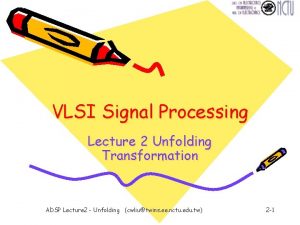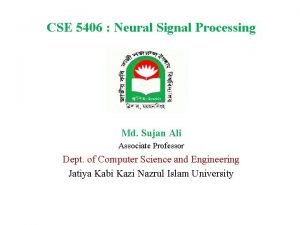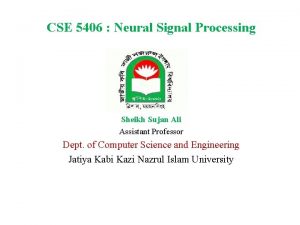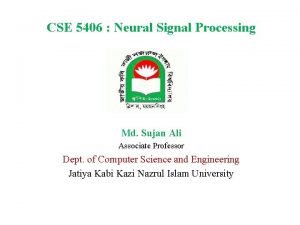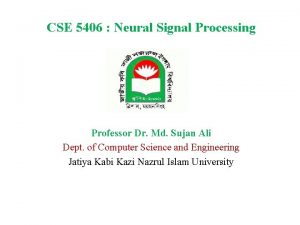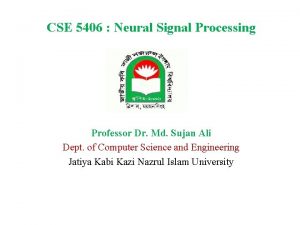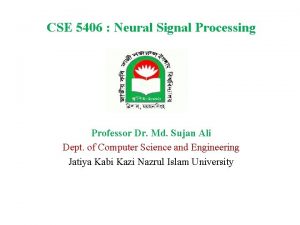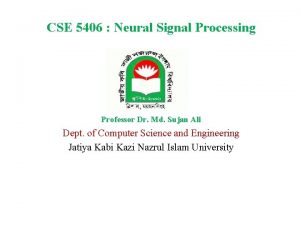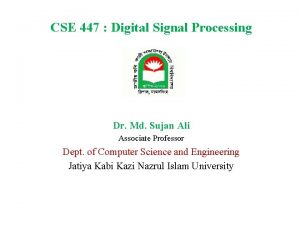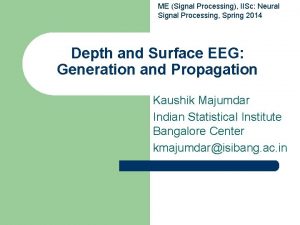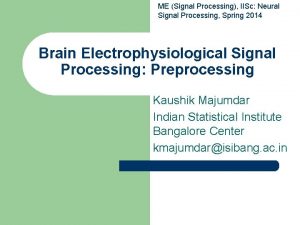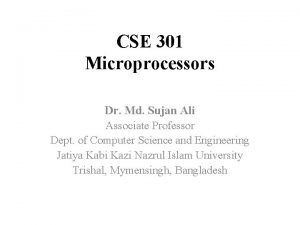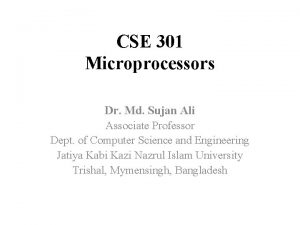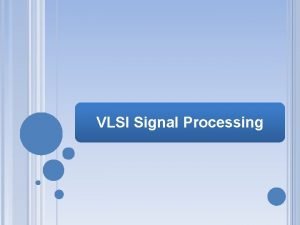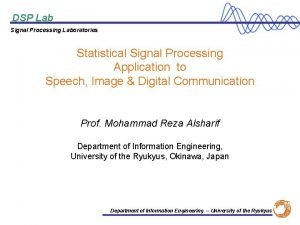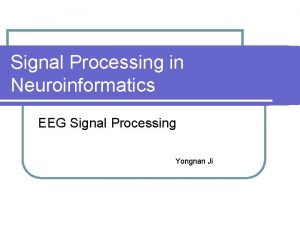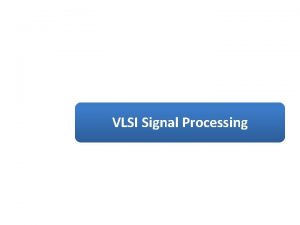CSE 5406 Neural Signal Processing Md Sujan Ali



























- Slides: 27

CSE 5406 : Neural Signal Processing Md. Sujan Ali Associate Professor Dept. of Computer Science and Engineering Jatiya Kabi Kazi Nazrul Islam University

Time-Frequency Representation Time Domain The time domain refers to the analysis of mathematical functions or signals with respect to time. Frequency Domain The frequency domain refers to the analysis of mathematical functions or signals with respect to frequency, rather than time. September 12, 2021 2

Time-Frequency Representation Time-frequency representation A time–frequency representation (TFR) is a view of a signal represented over both time and frequency. September 12, 2021 3

Time-Frequency Representation Fourier Transform The Fourier transform decomposes a function of time (a signal) into the frequencies that make it up. Where, September 12, 2021 4

Time-Frequency Representation Discrete Fourier Transform (DFT) September 12, 2021 5

Time-Frequency Representation Discrete Fourier Transform (DFT) September 12, 2021 6

Time-Frequency Representation Window Function • In signal processing, a window function is a mathematical function that is zero-valued outside of some chosen interval. For instance, a function that is constant inside the interval and zero elsewhere is called a rectangular window September 12, 2021 7

Time-Frequency Representation Other types of windows • Hanning window September 12, 2021 8

Time-Frequency Representation • Hamming window September 12, 2021 9

Time-Frequency Representation • Blackman window September 12, 2021 10

Time-Frequency Representation Need of window function • Signal segments are finite and not periodic. • Signal segment generates a jump discontinuity. • Such jumps result in an artifacts in the FFT amplitudes. • To make the end points smooth. September 12, 2021 11

Time-Frequency Representation Limitations of DFT 1. Do not give time information 2. Do not work for non-stationary signals September 12, 2021 12

Time-Frequency Representation Short Time Fourier Transform (STFT) September 12, 2021 13

Time-Frequency Representation Short Time Fourier Transform (STFT) September 12, 2021 14

Time-Frequency Representation Heisenberg Uncertainty Principle • This principle originally applied to the momentum and location of moving particles. • It can be applied to time-frequency information of a signal. • It states that one cannot know the exact time-frequency representation of a signal, i. e. , one cannot know what spectral components exist at what instances of times • One can only know the time intervals in which certain band of frequencies exist. • Which is a resolution problem of STFT. September 12, 2021 15

Time-Frequency Representation Limitations of STFT Resolution problem Narrow window ===>good time resolution, poor frequency resolution. Wide window ===>good frequency resolution, poor time resolution. September 12, 2021 16

Time-Frequency Representation Limitations of STFT September 12, 2021 17

Time-Frequency Representation Wavelet Transform • Wavelet A wavelet is a small wave with an amplitude that begins at zero, increases, and then decreases back to zero. Maxican hat wavelet Morlet wavelet Meyer wavelet September 12, 2021 18

Time-Frequency Representation Wavelet Transform • Wavelet with different scales September 12, 2021 19

Time-Frequency Representation Continuous Wavelet Transform (CWT) The transformed signal is a function of two variables, tau and s, the translation and scale parameters, respectively. psi(t) is the transforming function, and it is called the mother wavelet. There are two main differences between the STFT and the CWT: • The Fourier transforms of the windowed signals are not taken. • The width of the window is changed as the transform is computed for every single spectral component, which is probably the most significant characteristic of the wavelet transform. September 12, 2021 20

Time-Frequency Representation Continuous Wavelet Transform (CWT) Cosine signals corresponding to various scales September 12, 2021 21

Time-Frequency Representation Continuous Wavelet Transform (CWT) COMPUTATION OF THE CWT Let x(t) is the signal to be analyzed. • The procedure will be started from scale s=1 and will continue for the increasing values of s. • The wavelet is placed at the beginning of the signal at the point which corresponds to time=0. • The wavelet function at scale 1 is multiplied by the signal and then integrated over all times. • The result of the integration is then multiplied by the constant number 1/sqrt{s}. This multiplication is for energy normalization purposes so that the transformed signal will have the same energy at every scale. September 12, 2021 22

Time-Frequency Representation Continuous Wavelet Transform (CWT) COMPUTATION OF THE CWT • The final result is the value of the transformation, i. e. , the value of the continuous wavelet transform at time zero and scale s=1. • The wavelet at scale s=1 is then shifted towards the right by tau amount to the location t=tau , and the above equation is computed to get the transform value at t=tau , s=1 in the time-frequency plane. • This procedure is repeated until the wavelet reaches the end of the signal. One row of points on the time-scale plane for the scale s=1 is now completed. September 12, 2021 23

Time-Frequency Representation Continuous Wavelet Transform (CWT) COMPUTATION OF THE CWT • Then, s is increased by a small value. • This is a continuous transform, and therefore, both tau and s must be incremented continuously. • The above procedure is repeated for every value of s. • Every computation for a given value of s fills the corresponding single row of the time-scale plane. • When the process is completed for all desired values of s, the CWT of the signal has been calculated. September 12, 2021 24

Time-Frequency Representation Output Tiling September 12, 2021 25

Time-Frequency Representation Digital Filters • In signal processing, a digital filter is a system that performs mathematical operations on a sampled, discrete-time signal to reduce or enhance certain aspects of that signal. September 12, 2021 26

Time-Frequency Representation FIR Filters • In signal processing, a finite impulse response (FIR) filter is a filter whose impulse response (or response to any finite length input) is of finite duration, because it settles to zero in finite time. Where N is filter order September 12, 2021 27
 Dr sujan ali
Dr sujan ali 80846 microprocessor
80846 microprocessor Digital signal processing
Digital signal processing Xray mastoid townes view
Xray mastoid townes view Dr sujan ali
Dr sujan ali Sylhost
Sylhost Resolución 5406 de 2015
Resolución 5406 de 2015 Efficient processing of deep neural networks
Efficient processing of deep neural networks Neural processing
Neural processing What is the product of an even signal and odd signal
What is the product of an even signal and odd signal Baseband signal and bandpass signal
Baseband signal and bandpass signal Baseband signal and bandpass signal
Baseband signal and bandpass signal Digital signal as a composite analog signal
Digital signal as a composite analog signal Digital filters
Digital filters Super audio cd
Super audio cd Advantages of dsp
Advantages of dsp Digital signal processing
Digital signal processing Digital signal processing
Digital signal processing Genomic signal processing
Genomic signal processing Pca vs ica
Pca vs ica Signal processing first
Signal processing first Signal processing solutions
Signal processing solutions Digital signal processing
Digital signal processing Digital signal processing
Digital signal processing What is digital signal processing
What is digital signal processing What is digital signal processing
What is digital signal processing Signal processing for big data
Signal processing for big data Unfolding in vlsi signal processing
Unfolding in vlsi signal processing
